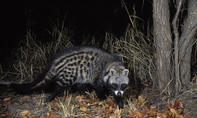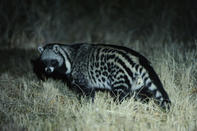Sweet Perfume
Civets are stocky animals that resemble cats but are closer to dogs in size. They belong to neither of those carnivore families but rather are part of the Viverridae, the same family as mongoose.

The viverrids all have well developed anal glands for scent marking and the civet is no exception. The dark secretion from a civet’s anal glands is known as civetone and is most pungent in smell. It is used to mark territory by wiping the everted gland against smooth objects.
Civets may reverse backwards up a rock or tree to deposit the secretion as high up as possible. This may be a ploy to make themselves seem bigger to intruders as the smell is so elevated. They also use their anal gland secretions as a chemical defence against predators. It has a long lasting smell, lasts for 3 months, which led to the substance being used as a fixative in women’s perfumes.
Clear Markings

The striking black and white colouration that the civet has is aposematic, meaning that it is obvious to night-vision animals and warns such predators of the civet’s chemical tactics, cautioning them to stay clear. The white patches on the civet’s face highlight its facial expressions when it encounters other civets.
Civets live alone hiding in holes or in dense undergrowth by day. They are shy and freeze when threatened and then slip silently away. Civets also display pilo-erection when under stress raising the longer-haired crest of fur along their backs and standing side-on to the predator or intruder to seem larger and more intimidating.
By Megan Emmett